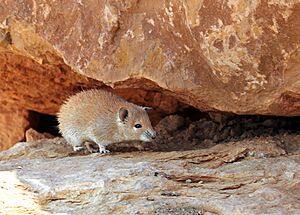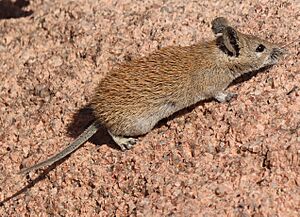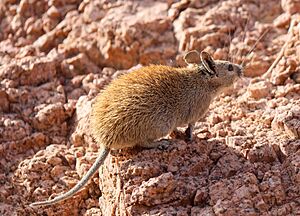Golden spiny mouse facts for kids
Quick facts for kids Golden spiny mouse |
|
|---|---|
 |
|
| Conservation status | |
| Scientific classification | |
| Genus: |
Acomys
|
| Species: |
russatus
|
| Synonyms | |
|
Acomys lewisi |
|
The golden spiny mouse (Acomys russatus) is a fascinating rodent. It gets its name from its reddish-orange, spiky fur. This stiff fur covers its body and helps protect it from predators. Its head and upper body are golden, while its sides are yellow and its belly is pale. It has gray legs with light feet and black soles. You might also notice a small white spot under each eye.
Sometimes, you'll see a golden spiny mouse missing part or all of its tail. This is because it can drop its tail as a way to escape danger! Scientists don't fully understand how or why this happens. In the wild, these mice usually live for about three years. They are omnivores, meaning they eat both plants and animals. Their diet includes seeds, desert plants, snails, and insects.
Golden spiny mice live in desert areas. They are xeric animals, which means they are very good at living in dry places. They get most of their water from the plants they eat. To save water, they produce very concentrated urine.
Normally, A. russatus is nocturnal, meaning it is active at night. But it can adapt to be active during the day if it shares its home with another type of spiny mouse, the A. cahirinus. This amazing ability helps them avoid competition for food.
Where the Golden Spiny Mouse Lives
The golden spiny mouse loves dry, hot deserts. You can find it in Egypt and many parts of the Middle East. This includes countries like Jordan, Israel, Oman, Saudi Arabia, and Yemen.
These mice are limited to warm areas because their bodies don't produce heat as quickly as other animals their size. This means they can't stay warm enough in cold places. They struggle when temperatures drop below 18 °C. However, they can live in very hot temperatures, up to 42.5 °C! One group of these mice was even found in the high mountains of southern Sinai. It gets very cold there, and it often snows in winter.
A. russatus is also excellent at saving water. They get very little water from their diet of insects and plants. They save water by making their urine super concentrated. This means they could even survive by drinking sea water, which is very rare for mammals!
Life Cycle: How Golden Spiny Mice Have Babies
Golden spiny mice are opportunistic breeders. This means they can have babies whenever conditions are good, not just during a specific season. They become ready to have babies when they are about 58 days old.
Female spiny mice can have babies all year long. On average, each female has about 3.5 litters of babies per year. There are usually about 34 days between litters. They are viviparous, which means their babies develop inside the mother's body. Each pregnancy lasts about 5–6 weeks. A mother usually gives birth to 1 to 5 babies at a time. The babies are nursed for about two weeks.
When there is less rain, the plants they eat can become saltier. This can make it harder for both male and female mice to have babies.
Day or Night? The Golden Spiny Mouse's Amazing Schedule
One of the most studied things about the golden spiny mouse is its ability to change its daily schedule. Normally, it is nocturnal, meaning it's active at night. But it can switch to being diurnal, or active during the day. This happens when it shares its home with another type of spiny mouse, Acomys cahirinus.
Both species eat the same kinds of food. If they were both active at the same time, they would compete too much. The golden spiny mouse is better at handling hot temperatures and saving water. So, it's the one that changes its schedule to be active during the day. This helps them avoid fighting over food. When this switch happens, their whole body clock, called a circadian rhythm, changes. This affects things like their metabolism (how their body uses energy) and how they get rid of waste. This new schedule can even adjust to how long the days are in different seasons.
However, it's clear that the golden spiny mouse hasn't fully evolved to be a daytime animal. If there are no other mouse species around in a lab, they immediately go back to being active at night. This shows that being active during the day is something they do only when they have to. Also, their eyes are still like those of a nocturnal animal, not a daytime one. They also prefer to look for food in darker places, like under rocks. All of this shows that if they didn't have to compete, golden spiny mice would rather be active at night.




